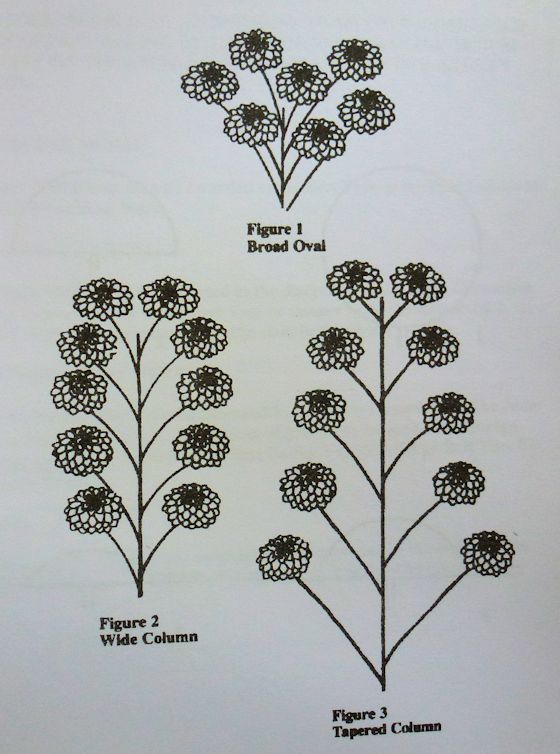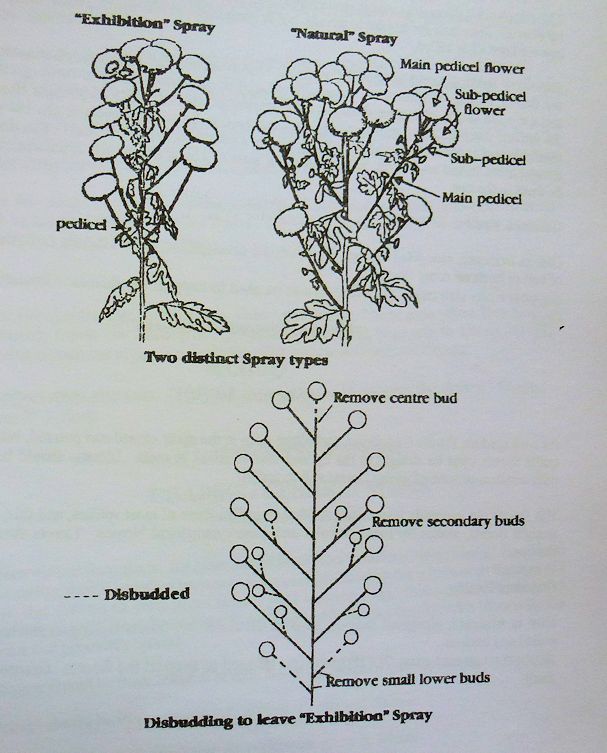Spray Crysanths - showing
SPRAYS
(Sections, 8,9,18,19,28,29)
Six bloom types are listed under sprays:
Anemones - e.g Oriels
Pompons
Reflexed - e.g Talbots and Margarets
Singles - e.g Embees and Southways
Intermediate - e.g Pennine Swan
Spiders, quills, spoons, (single or double) and any other types
Sprays can be exhibited in two forms, either as NATURAL sprays or EXHIBITION sprays.
A NATURAL SPRAY is a lateral with flowers ranging from bud to fully developed and conforming to one of the accepted spray forms. This type of spray should not be disbudded other than possibly the crown bud, Natural sprays will be judged under Table C of The National Chrysanthemum Society points system.
An EXHIBITION SPRAY with only one bloom on a pedicel is regarded as the perfect spray form, and where classes are provided for the sprays they should be asked for and presented in exhibition form.
In cases where an exhibition spray has compounded with more than one bloom on a pedicel secondary blooms (or secondary buds) on sub-pedicels should be removed. The removal should be carried out neatly and no unsightly stubs of stems should remain.
A natural pedicel desirable as opposed to a disbudded pedicel and excessive disbudding shall be down pointed.
Maximum recommended staging height is 30 inches from the top of the vase. The recommended minimum number of blooms is 4 per stem and the number of blooms shall be determined by the potential of the cultivar.
Where a secondary bloom and/or bud has not been removed the exhibit will be down pointed.
The presence of a secondary bloom is regarded as a major fault, and secondary bud in the flower head will also be deemed a serious defect. An unobtrusive secondary bud below the flower head will also be subject to less severe penalty, but in classes calling for only exhibition sprays, a spray exhibited in overall natural form will render the exhibit NAS.
A spray should conform to one of the three symmetrical forms or types (see diagram)
The broad oval type should have not less than 4 blooms positioned above and around its main stem. Pedicels should be of the same sufficient length to impart breadth to the spray. Sprays with only a few blooms clustered close together at the crown are inferior to those carrying more blooms at intervals down the stem and imparting depth to the spray.
The column type should have not less than 8 blooms positioned around the main stem to form a wide or tapered column. Sprays with only a few blooms at the top of the column are inferior to those carrying more blooms at intervals down the stem and imparting depth to the spray.
Blooms of exhibition sprays should be spaced so each bloom can be observed individually, they should be approximately equal in size and stage of development, of good colour for the cultivar and conforming to general standards quality they represent, though the reflexing type is acceptable in more shallow form than is the case with disbudded exhibition blooms.
If the central bloom is more advanced in its development and out of balance and is crowding the centre it should also be removed. Central blooms positioned well below the contour of the crown of the spray should also be removed.
Foliage should be small and clean and should provide a pleasing setting to the blooms.
When showing exhibition sprays the schedule should ask for so many “stems of sprays” stating that the exhibits will be judged under Table D of The National Chrysanthemum Society points system.
However is some classes the strict requirements of the exhibition spayed are relaxed so that sprays that have been grown naturally with flowers ranging from bud to fully developed may be exhibited without the removal of the secondary blooms.
In this case schedules should ask for many “stems of sprays” stating that both natural and exhibition sprays are eligible the exhibits will be judged under Table C of The National Chrysanthemum Society points system.
Table C Natural sprays |
Table D Exhibition sprays |
||||
Sections 8,9,18,19,28,29 |
Sections 8,9,18,19,28,29 |
||||
BLOOM QUALITY |
Form |
15 |
BLOOM QUALITY |
Form |
15 |
Freshness |
25 |
Freshness |
20 |
||
Colour |
15 |
Colour |
10 |
||
OVERALL EFFECT |
Size |
5 |
|||
incl progression of development & staging |
40 |
SPRAY QUALITY |
Form |
15 |
|
FOLIAGE |
5 |
Uniform placement & development |
15 |
||
100 |
OVERALL EFFECT |
staging and number of blooms |
15 |
||
100 |
FOLIAGE |
5 |
|||
100 |
|||||


